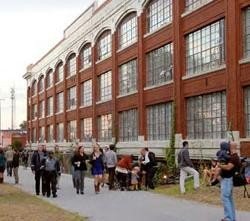Smart Growth and Infill Brownfields Redevelopment
- Using Smart Growth to Enable Infill Brownfields Redevelopment
- Research and Tools
- Successful Case Studies
Using Smart Growth to Enable Infill Brownfields Redevelopment
Brownfields are abandoned, vacant, and/or unused sites that have been or are potentially contaminated from previous uses. These sites, often located in locations with existing transportation and utility infrastructure, these sites can be considered "infill" development sites and can be cleaned up and sustainably redeveloped into community and economic assets, such as parks and plazas, mixed-use developments, homes, or businesses.
Infill development can take development pressure off nearby green spaces and working lands, as it encourages the development (or redevelopment) of underused or vacant land, such as brownfields, in existing built areas. Infill development can be a useful tool to increase density or place new development near existing resources and infrastructure.
Brownfield properties are often centrally located in previously developed areas, which can make them valuable properties for redevelopment. When infill development occurs near transit or employment centers or near existing neighborhoods, it can reduce the distance people need to drive and give them other transportation options.
However, the process of safely remediating the sites can add costs to a redevelopment project. Supportive land use policies can reduce the cost of redeveloping brownfield properties in these locations. Local government or municipalities can further incentivize infill redevelopment by planning for supportive infrastructure spending around existing brownfield properties.
The resources provided below can help your community learn about and begin to implement effective strategies for planning for and implementing brownfields redevelopment projects.
Research and Tools
- Land Revitalization Toolkit (2023): Resource library with guides and tools to help a community navigate each stage of redeveloping contaminated sites.
- Attracting Infill Development in Distressed Communities: 30 Strategies (2015): Guide to help communities determine their readiness to pursue infill development and identify strategies to better position themselves to attract infill development.
- Smart Growth and Economic Success (2012-2014): A series of reports that shows that barriers to infill development are not only often surmountable, but also are diminishing as infill development becomes more common.
Successful Case Studies

- City Green: Innovative Green Infrastructure Solutions for Downtowns and Infill Locations (2016): Case studies of projects around the country that illustrate how green infrastructure techniques can be used on sites that have limited space and other constraints to bring environmental and community benefits.
- Atlanta BeltLine Eastside Trail and Historic Fourth Ward Park in Atlanta, Georgia (2013): The BeltLine park and trail, which had high levels of contamination that had to be cleaned up before development could begin, sparked economic development, community engagement, and new affordable housing options in nearby neighborhoods. Watch the video.
- La Valentina in Sacramento, California (2013): An energy-efficient, mixed-income, mixed-use apartment building on a former brownfield site next to a light-rail station is transforming an industrial area and giving residents transportation options. Watch the video.
- Equitable Redevelopment of Petroleum Brownfields for Zuni Pueblo and Other Tribal Communities (2013): This is a step-by-step guide to help Tribes overcome policy and other barriers to redevelopment of contaminated and vacant sites. (This publication is available in the EPA Archive. Click on SEARCH EPA ARCHIVE and type or copy and paste the title into the search box.)
- Plan El Paso in El Paso, Texas (2011): With robust community input, Plan El Paso 2010 created a vision for three environmentally sustainable, transit-oriented neighborhoods linked by bus rapid transit and anchored by the redevelopment of a 600-acre, former industrial brownfield site. Watch the video .
- Silver Gardens in Albuquerque, New Mexico (2011): Silver Gardens Apartments is a 66-unit, highly energy-efficient affordable housing development located on a reclaimed brownfield site in downtown Albuquerque near the city's primary transit hub. Watch the video .
